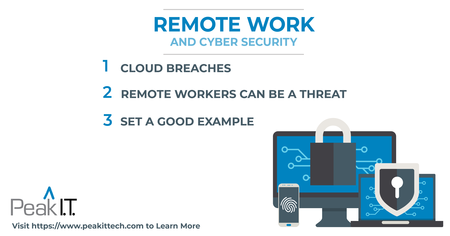Remote work has worked! This is a great sign, but how can we continue the success? Security breaches and attempts skyrocketed in 2020 and with companies continuing to work remotely and implement at home strategies the looming threat of a breach becomes more and more real. Today we are going through the most frequently targeted structures of your business, secret threats, and how to start a change in your cybersecurity strategy.
Cloud Breaches
If your company operates in a cloud environment this will be targeted the most. This is an extremely secure structure with two-factor authentication, secure passwords, and the correct access being given. Two-factor authentication will allow you to be notified whenever anyone (including yourself) is trying to log into your account. You will even be given the option to deny the log in.
Making a secure password will help secure your account from making it easy to get into and correct access will limit the amount of people who have access to certain documents and files within your cloud structure. This will limit the number of attempts that will be made on crucial information within your database. If all of this is done, your company should be secure, but that won’t stop the attempts at your account. Taking these steps will help to prevent breaches amongst all of the threats within your company.
Remote Workers can be a threat
Having remote workers is great. They are just as productive, spreading infection during a pandemic is decreased, and costs can potentially be reduced long term. All of this sounds like remote work is a no brainer, but there are certain security threats that can make a company think twice about how many remote workers they have. Remote workers are a part of the reason that cyber threats increased during the pandemic. Home wifi networks aren’t as secure and hackers took advantage of this. Breaches were more and more frequent as the remote workers continued to work from home. Making sure your remote workers have taken the necessary steps to protect your company’s network is essential to its survival.
Set a good example
Starting from the top down is a great way to implement a security strategy within your company. If you are in a position of leadership, just telling someone to strengthen their cybersecurity tactics isn’t good enough. You need to do it yourself and lead the company into a more secure state. This means training, implementing, and using the security measures yourself first and then getting your team to get on board. This will prove that your company is serious about these security measures and that it is a permanent fixture in your company.
Security measures are essential to the survival of your company. If they are measured carefully and you make sure that everyone buys in, especially remote workers, your company will be better for it. Knowing that you are secure will make it easier to focus on work, rather than who is targeting your information.

